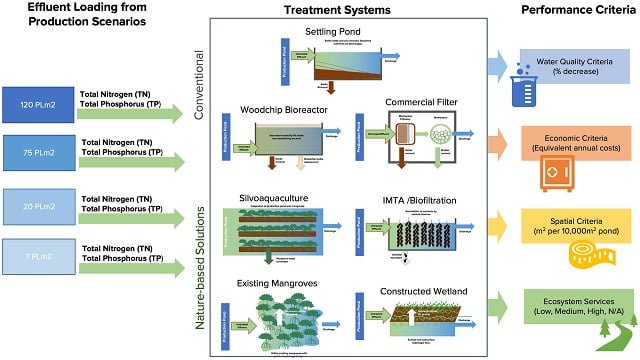
As the marine shrimp aquaculture sector evolves from extensive to intensive production, new environmental challenges arise, particularly concerning water quality impacted by nutrient-rich effluents.
While coastal habitat conversion was a predominant concern in the past, the shift towards intensified production necessitates the assessment of efficient and ecological solutions. In this regard, the need to compare the performance of Nature-Based Solutions (NbS) and conventional approaches in effluent treatment becomes evident.
In a new study, researchers from Conservation International and Alune Aqua Ltd. evaluate the potential of both conventional effluent treatment options and Nature-Based Solutions (NbS), with a focus on addressing nutrient-rich effluents and mitigating the impacts of historical mangrove loss.
Evolving Environmental Challenges in Shrimp Aquaculture
The global marine shrimp aquaculture industry has undergone a transformation from extensive to intensive production methods. While addressing certain concerns, this shift has introduced new environmental risks, particularly related to water quality and nutrient-laden effluents.
Given rapid climate changes and coastal marine conditions, the shrimp aquaculture sector should consider systems that provide ecosystem services, especially those that can enhance coastal adaptation and resilience to natural disturbances.
Comparison of Effluent Treatment Options
The primary goal of the study is to compare the performance of conventional effluent treatment systems and Nature-Based Solutions (NbS), specifically in the context of intensified shrimp aquaculture.
Approaches utilizing Nature-Based Solutions, designed around the system, can provide ecosystem benefits. NbS are considered a cost-effective tool for restoration, but their viability and potential application in aquaculture systems still need evaluation.
Methodology and Scope
The study examines various effluent treatment systems suitable for shrimp aquaculture in Asia, using secondary data to assess their feasibility.
Four population density scenarios (7PLm-2, 20PLm-2, 75PLm-2, and 120PLm-2) are considered to estimate treatment efficiency, economic viability, spatial requirements, and potential for ecosystem service provision.
Key Findings and Implications
“Our results suggest that constructed mangrove wetlands for mangrove treatment, a type of NbS approach, are not only an economically viable option for effluent management compared to more conventional approaches like sedimentation ponds, but they can also provide additional ecosystem services,” the researchers report.
The study’s findings provide a solid conceptual framework for evaluating the characteristics and trade-offs of different effluent treatment systems:
- Nature-Based Solutions (NbS): Constructed artificial mangrove wetlands emerge as a promising NbS approach. This method not only effectively addresses the effluent treatment needs of aquaculture but also offers competitive costs. Additionally, NbS methods like mangrove wetlands provide valuable collateral benefits of ecosystem services, contributing to overall environmental sustainability.
- Economic Viability: The study evaluates the economic viability of various treatment options. NbS approaches, particularly constructed artificial mangrove wetlands, demonstrate potential profitability while offering multiple benefits.
- Environmental Co-Benefits: Nature-Based Solutions have the potential to restore lost ecosystem services due to mangrove deforestation, contributing to habitat preservation and biodiversity conservation.
Conclusion
As the Asian shrimp aquaculture industry faces challenges of intensified production and historical ecological degradation, effluent treatment becomes a crucial consideration.
The study highlights the promising role of Nature-Based Solutions, such as constructed artificial mangrove wetlands, in efficiently addressing effluent treatment needs while simultaneously promoting ecological restoration and sustainable economic practices.
“Our study demonstrates how an NbS approach can be applied to shrimp aquaculture while meeting commercial production needs and trends towards intensification,” they concluded.
By embracing innovative approaches that balance productivity with environmental conservation, the shrimp aquaculture sector can pave the way for a more sustainable future.
The study was funded by The David and Lucile Packard Foundation and the Foundation of Success.
Contact
Garrett M. Goto
Conservation International
Arlington, Virginia, United States of America
Email: ggoto@conservation.org
Reference (open access)
Goto GM, Corwin E, Farthing A, Lubis AR, Klinger DH (2023) A nature-based solutions approach to managing shrimp aquaculture effluent. PLOS Sustain Transform 2(8): e0000076. https://doi.org/10.1371/journal.pstr.0000076

